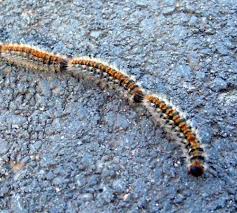In Spain, the crawlies are usually creepier, bigger and more dangerous than anything you may have come across in the UK. And the Pine Caterpillar, also known as the Processional Caterpillar, is really nasty. What it lacks in size it makes up for in nuisance value and danger to pine trees, pets and people.
These are not fluffy and friendly like those 'wooly bear' caterpillars that schoolboys love to terrorise schoolgirls with - or was it only me that used to get them stuffed down the back of my liberty bodice? The hairs of the Pine Caterpillar are poisonous, and can cause rashes, pain and, in the case of puppies or kittens, even death. As you’d expect from the name, they live in large, cocoon-like nests in pine trees. They strip the trees of their needles, then march in a nose-to-tail procession to the next healthy tree. For little critters, they have a voracious appetite and can demolish whole pine forests in no time.
Pine Caterpillars are usually active from January to April, and are most dangerous in the middle of February. We’re lucky in that we have no pine trees close to our property, but if you have Pine Caterpillars for neighbours, there is really only one safe solution – exterminate! Those of a nervous disposition may want to look away now, because here's how to conduct your very own Pine Caterpillar Massacre.
If the caterpillars are in procession on the ground, spray them with lighter fuel, then set fire to them. If you find cocoons in your pine trees, first spray with hairspray to minimise the risk of flying hairs. Then use a stick and a pair of tree loppers to cover the cocoon with a plastic bag, cut off the infested branch and then burn the whole cocoon. Just be careful not to start a forest fire, won’t you?
Is all this really necessary? Well, yes it is, because just as a wasp can still sting after death, the Pine Caterpillars’ hairs remain poisonous, so cremation is the only safe answer. If you feel guilty about causing such suffering to one of God’s creatures, just think of it as war. What would you rather have? A flame-grilled caterpillar or a child in pain and distress after getting too close to this nasty specimen of the natural world?
If you live near pine trees, keep in some antihistamines in case anyone comes into contact with Pine Caterpillars. If one lands on you or a member of your family, resist the urge to brush it off with your hands, Use a stick, or shake your clothes to remove it. If a member of your family or a pet shows any signs of shock after being in contact with a Pine Caterpillar, seek medical or veterinary advice immediately. Be careful out there!
